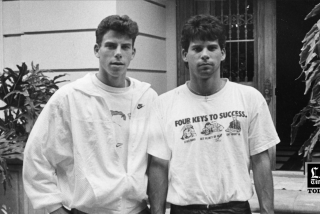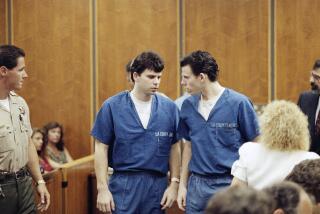Singer helped make Tejano music popular
Lydia Mendoza, an early star of Mexican American music whose passionate, despairing songs about working-class life on both sides of the border made her a trailblazer for the Tejano genre, has died. She was 91.
Mendoza, whose singing career spanned more than 60 years, died Dec. 20 of natural causes in San Antonio, Texas, according to media reports.
Texas Monthly magazine called her the “greatest Mexican American female performer ever to grace a stage” in a 1999 story that named her “the voice of the century” in Texas.
Lupe Saenz, president of the South Texas Conjunto Assn., told The Times that Mendoza was a “pioneer of our musical heritage.”
“She was a rebel, in that she did what no other woman artist singer had done before her; that is, she sang about the ‘machismo’ culture in a way that set the course for many women today,” Saenz said in an e-mail.
The words for her first, and most enduring, hit came from her girlhood collection of gum wrappers that contained song lyrics. She put the words from one wrapper to a tune she had heard in concert in Mexico and first performed “Mal Hombre” (Evil Man), a song about false-hearted lovers, when she was 10.
After Mendoza recorded the song -- a tango -- in 1934, it became a major hit throughout the Spanish-speaking community and launched her career.
Accompanied by her signature 12-string guitar, Mendoza often sang about hardship and rejection in a powerfully sincere style that reflected the music developing along the U.S.-Mexican border. Her trilling voice earned her the nickname “La Alondra de la Frontera,” or Lark of the Border.
In 1935, she married shoemaker Juan Alvarado and continued to perform in an era when wives usually gave up their careers. By 1940, Mendoza had recorded more than 200 songs in a wide variety of musical styles that included boleros, rancheras and cumbias. She wrote many of them herself.
“People say I’m the mother of Tejano music,” Mendoza told the Chicago Tribune in 1996, “but I don’t think I even heard the word, knew what it was, until many years after I started. . . . People watched what I was doing -- singing and playing guitar -- and that inspired them.”
She performed at the 1977 inauguration of President Carter and in 1999 received a National Medal of Arts, which recognizes outstanding contributions to the field. At a ceremony, President Clinton praised her for bridging “the gap between generations and cultures.”
“Lydia Mendoza is a true American pioneer,” Clinton said, “and she paved the way for a whole new generation of Latino performers who today are making all Americans sing.”
She was born May 12, 1916, in Houston to Francisco and Leonor Mendoza. Her family came from northern Mexico, and she and several siblings grew up moving between Monterrey, Mexico, and south Texas.
Her mother played the guitar and sang Mexican songs, which made Mendoza wish for a guitar of her own. At 4, she made one out of a plank of wood, six nails and several rubber bands.
“It made a sound -- I was happy enough,” Mendoza told the Houston Chronicle in 2001.
When her father became too ill to work as a railroad mechanic, she began performing with her parents and a sister on the streets and in restaurants of border towns.
In 1928, her father answered an ad in a San Antonio newspaper placed by a New York company looking to record Spanish-language musicians. Family members recorded their first record in a hotel room and were paid $140 for 20 songs.
Still needing to find regular jobs, the Mendozas moved to Michigan to work in the vegetable fields. Upon hearing the family perform, co-workers encouraged them to play in town, and they spent several years working and performing in small restaurants.
Back in Texas in the early 1930s, the family often played for tips at an outdoor market in San Antonio, where the host of a local Spanish-language radio show heard Mendoza sing. She was soon performing on the radio for $3.50 a week.
The radio show made her popular in the region, and the repeal of Prohibition in 1933 created opportunities for musicians in cantinas.
Eventually, the family began touring throughout the Rio Grande Valley in southern Texas. Mendoza performed solo while her siblings sang together and put on a variety act.
“The very sight of her was magical and could awaken a populist frenzy and collective pride in Mexicans,” Yolanda Broyles-Gonzalez wrote in her 2001 book, “Lydia Mendoza’s Life in Music.”
Even after having three daughters, Mendoza kept performing, but gas rationing during World War II temporarily ended her touring.
In 1947, she returned to the road, but the family group broke up in 1952 after her mother died and a sister married.
Although her status as an idol peaked during the 1950s, Mendoza continued recording and touring as a solo act until a series of strokes forced her to retire in 1988.
After her husband died in 1961, she married another shoemaker, Fred Martinez, in 1964 and they moved to Houston, where she often performed in small nightclubs. She drew from a repertoire of 1,200 songs spanning nearly 100 years.
Mendoza is survived by a daughter, Yolanda Hernandez.
--
More to Read
The biggest entertainment stories
Get our big stories about Hollywood, film, television, music, arts, culture and more right in your inbox as soon as they publish.
You may occasionally receive promotional content from the Los Angeles Times.











